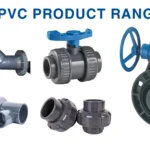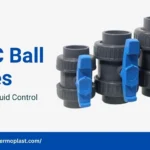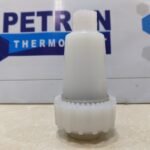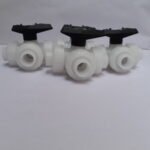Installation of Ball Valve in a PVC Water Line. When it comes to controlling the flow of water in a PVC (Polyvinyl Chloride) water line, ball valves stand as a reliable and efficient choice. These valves, known for their exceptional shut-off capabilities, are commonly used in plumbing systems for residential, commercial, and industrial applications. In this comprehensive guide, we will delve into the installation process of a ball valve in a PVC water line, exploring the necessary steps and highlighting the key considerations to ensure a smooth and leak-free operation.
Understanding Ball Valves:
Before we proceed with the installation, let’s take a moment to understand what ball valves are and how they work. A ball valve is a type of quarter-turn valve that uses a hollow, perforated, and pivoting ball to control the flow of water. When the handle is turned, the ball inside the valve rotates, either allowing water to pass through or blocking its flow entirely. This simple yet ingenious design makes ball valves ideal for on/off applications and flow regulation in plumbing systems.
Essential Tools and Materials Required for Installation of Ball Valve in a PVC Water Line:
To begin the Installation of Ball Valve in a PVC Water Line, gather the necessary tools and materials:
- Ball valve: Select a high-quality ball valve that suits the size and requirements of your PVC water line.
- PVC pipes: Ensure you have the appropriate PVC pipes of the required diameter and length.
- PVC primer and cement: These are essential for securely connecting the pipes and fittings.
- Teflon tape: Used for creating a tight seal between threaded connections.
- Hacksaw: For cutting the PVC pipes to the desired lengths.
- Marker: To mark the cutting points on the pipes accurately.
- Measuring tape: For precise measurements of the pipes and fittings.
- Rags: To wipe off any excess primer or cement during the installation.
- Adjustable wrench: For tightening the ball valve and other connections.
Step-by-Step Installation Guide:
Now, let’s dive into the step-by-step process of installing a ball valve in your PVC water line:
Step 1: Safety First
Before you begin any plumbing work, always prioritize safety. Turn off the main water supply to avoid accidental flooding or water wastage during the installation process.
Step 2: Measure and Mark
Measure the section of the PVC water line where you intend to install the ball valve. Use a marker to mark the cutting points accurately.
Step 3: Cut the PVC Pipe
Using a hacksaw, carefully cut the PVC pipe at the marked points. Ensure that the cuts are straight and smooth for a proper fit.
Step 4: Prepare the Pipes and Fittings
With the PVC pipes cut to size, use the PVC primer on the outside of the pipe end and the inside of the ball valve socket. Apply PVC cement to the same areas. Make sure to work quickly as the cement dries fast.
Step 5: Assemble the Ball Valve
Insert the primed end of the PVC pipe into the socket of the ball valve and give it a quarter turn to ensure a secure connection. Hold the pipe in place for a few seconds to allow the cement to set.
Step 6: Attach the Second Pipe
Repeat the priming and cementing process on the other end of the ball valve. Then, insert the second PVC pipe and turn it to secure the connection.
Step 7: Use Teflon Tape
If your ball valve has threaded connections, wrap Teflon tape around the male threads before attaching any fittings. This will help create a tight and leak-free seal.
Step 8: Finalize the Installation
After connecting the ball valve to the PVC water line, double-check all the connections for tightness and accuracy. If everything looks good, turn on the main water supply and test the valve to ensure it operates smoothly.
Step 9: Inspect for Leaks
Even though PVC cement provides a strong bond, it’s essential to inspect the entire installation for any signs of leaks. Run water through the valve and examine all joints and connections for potential leaks. If you find any, turn off the water supply immediately and make necessary adjustments.
Step 10: Maintenance and Care
Congratulations! Your ball valve is now successfully installed in the PVC water line. To ensure its longevity and optimal performance, perform regular maintenance checks on your plumbing system. Look out for signs of wear, corrosion, or leaks, and address any issues promptly.
Benefits of Ball Valves in PVC Water Lines:
Installation of Ball Valve in a PVC Water Line brings a plethora of benefits:
- Reliable Shut-Off: Ball valves offer a reliable and quick shut-off capability, ensuring immediate control over the water flow.
- Minimal Pressure Drop: These valves present minimal resistance to water flow, resulting in a negligible pressure drop.
- Durability: Constructed from sturdy materials like PVC and stainless steel, ball valves exhibit excellent durability and longevity.
- Versatility: Ball valves can be used for various applications, from simple household plumbing to complex industrial systems.
- Easy Operation: The quarter-turn operation of ball valves makes them easy to use and suitable for both manual and automated control systems.
- No Water Hammer: The swift closure of a ball valve prevents water hammer, which is common with slower-acting valves.
- Corrosion Resistance: PVC ball valves are highly resistant to corrosion and are ideal for use in water systems.
Common Applications:
Ball valves find extensive use in a wide range of applications, including:
- Residential Plumbing: Controlling water flow in household plumbing systems, such as sinks, toilets, and showers.
- Irrigation Systems: Regulating water flow in agricultural and landscaping irrigation systems.
- Industrial Processes: Managing water flow in industrial processes and pipelines.
- Water Treatment: Facilitating water treatment and distribution processes.
- Swimming Pools and Spas: Controlling water flow in swimming pools and spa systems.
- Chemical Handling: Handling and controlling the flow of various chemicals in industrial setups.
- Oil and Gas Industries: Employed in oil and gas pipelines and refineries.
Conclusion:
The Installation of Ball Valve in a PVC Water Line is a fundamental skill for any homeowner or aspiring DIY enthusiast. Understanding the working principles and following the step-by-step guide provided here will enable you to carry out this task confidently and efficiently. Remember to prioritize safety, use the right tools and materials, and perform regular maintenance to keep your plumbing system in excellent working condition.
Integrating a ball valve into your PVC water line offers not only precise control over water flow but also peace of mind, knowing you have a robust and reliable solution for your plumbing needs. So, go ahead and tackle this plumbing project with confidence, and enjoy the benefits of a well-installed ball valve in your PVC water line for years to come.
You may also like – Polycarbonate Sheet | Acrylic Plastic Sheet | Peek Material
FAQs:
How do you install a valve on PVC pipe?
To install a valve on PVC pipe, first, cut the pipe to the desired length. Apply primer and cement to the pipe end and the valve socket. Insert the pipe into the valve socket and turn to secure the connection.
Can you use a ball valve for main water line?
Yes, you can use a ball valve for the main water line. Ball valves are suitable for controlling water flow and provide a reliable shut-off capability, making them a popular choice for main water line applications.
Can I use PVC pipe for main water line?
Yes, you can use PVC pipe for the main water line. PVC pipes are a popular choice for water distribution due to their durability, corrosion resistance, and cost-effectiveness. Proper installation is crucial for long-term performance.
Which valve is used in main water line?
The ball valve is commonly used in the main water line for its reliable shut-off capabilities and minimal pressure drop, making it an ideal choice for controlling water flow in residential, commercial, and industrial applications.
- Why UPVC is the Best Choice for Piping & Plumbing Systems?
- The Growing Demand for PVDF Filters in Semiconductor Manufacturing
- The Future of UPVC Ball Valves in Industrial Fluid Control
- Why PVDF Check Valves Are the Best Choice for Harsh Chemical Environments
- Top PVDF Ball Valve Manufacturers: Quality, Durability & Performance









Pingback: marbo 9000
Pingback: โคมไฟ
Pingback: Jaxx Liberty
Pingback: เว็บตรงสล็อต
Pingback: Massage
Pingback: บาคาร่าเกาหลี
Pingback: lottorich28
Pingback: pgslot168